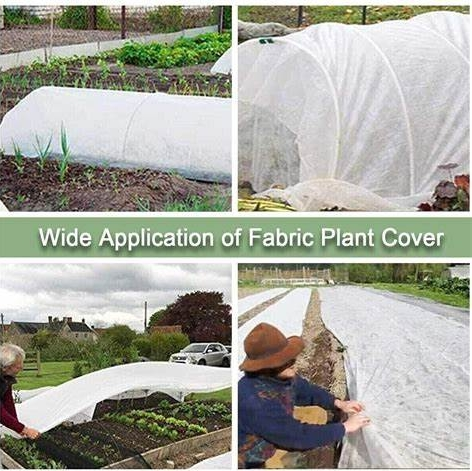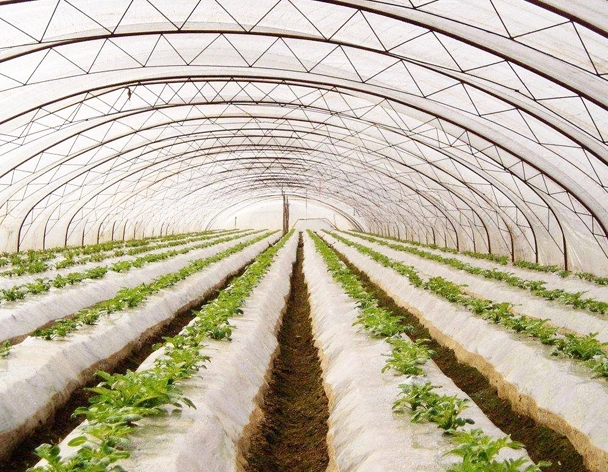Agricultural non-woven fabrics are generally made by heat-pressing polypropylene filament fibers. They possess good breathability, thermal insulation, moisture retention, and a certain degree of light permeability. Depending on their thickness, mesh size, color, and other specifications, they can be used as thermal insulation and moisture-retention covers, shading materials, isolation padding, packaging materials, and more.

The light permeability of non-woven fabrics decreases with increased thickness. For instance, 16g/m² white non-woven fabric has a light transmittance rate of 85.6%, while 30g/m² has only about 60%. The breathability of non-woven fabric weakens with increased thickness, but increases with higher external wind speed and greater temperature differences between inside and outside. The thermal insulation effect of non-woven fabric is influenced by its own thickness and mesh size, as well as external factors such as weather and covering methods. The lower the external temperature, the better the insulation effect. Insulation is more effective when used inside a greenhouse compared to open-field covering, and it warms more on sunny days than on cloudy or rainy days. Due to the temperature difference inside and outside the non-woven fabric, a “water film” often forms in its micropores, which can form a “frost layer” during frosty seasons, providing good thermal insulation. This is especially effective in conditions of high soil and air humidity, where the water film becomes more complete, enhancing insulation performance.
As a thermal insulation and moisture retention cover, non-woven fabrics can be used in three main ways.
Firstly, 30-35g/m² non-woven fabric can replace plastic film as a small greenhouse cover. It is generally used for early spring or autumn seedling cultivation. Its advantages include labor savings, no need to uncover for ventilation, watering directly on the fabric, and stable internal temperature changes. The seedlings grown are short, stout, and resistant to pests, with a high survival rate and quick adaptation after transplanting. In our provincial trials, using 35g/m² anti-aging non-woven fabric instead of plastic agricultural film for seedling cultivation resulted in shorter and stronger seedlings, a 10.8% increase in white roots, a 12.5% increase in stem width, a 52% increase in tillers, and completely eliminated the need for hardening and watering labor.
Secondly, for open-field floating coverage, 20-30g/m² non-woven fabric is directly laid on the bed surface or plants. Commonly used for winter and spring seedling cultivation and early spring leafy vegetables, it prevents bird pecking, retains heat and moisture, promotes germination, ensures uniform seedlings, promotes rooting and adaptation after transplanting, and enhances growth. Trials in Mian County showed that covering spring celery with 20g/m² non-woven fabric increased yield by 22.3-66.7%, increased value by 106-146%, increased early spring onion yield by 75%, and increased early spring cabbage yield by 43% and value by 70%. Agricultural non woven crop cover can also prevent frost damage when covering leafy and root vegetables for autumn extension supply.
Thirdly, it can be used as small greenhouse or floating cover material in large greenhouses or solar greenhouses, not only increasing temperature and yield but also absorbing moisture at night, reducing fog and humidity, and alleviating diseases.
When used as a shading material, dyed non-woven fabrics are generally hung or draped over the greenhouse roof to provide shade. The thickness and dyeing depth affect the shading rate. The advantage of non-woven fabrics as shading materials is that they not only block part of the sunlight, reducing the temperature below the fabric, but also convert direct light into scattered light, ensuring even light distribution and high utilization of transmitted light energy for the covered crops.

As isolation padding, non-woven fabrics are mainly used for seedling cultivation(Non-woven seedling bags), lawn cultivation, and soilless cultivation. They are breathable, water-permeable, easy to root through, beneficial for cultivating strong seedlings, and make seedling lifting easy without damaging roots. Generally, 20-30g/m² non-woven fabric is used, with nutrient soil spread on top and seeds sown for seedling cultivation. During seedling lifting, seedlings can be directly pulled up or rolled up with the fabric, eliminating the need for digging or cutting seedlings.
Non-woven fabric is a new type of basic material with wide applications in agriculture, and its uses are continuously expanding. This introduction covers only the most commonly used and early-developed applications. It is important to note that the yield-increasing effects of non-woven fabric can only be realized with proper technical support, and suitable specifications and application methods should be selected based on different regional climates, crops, and cultivation methods.
